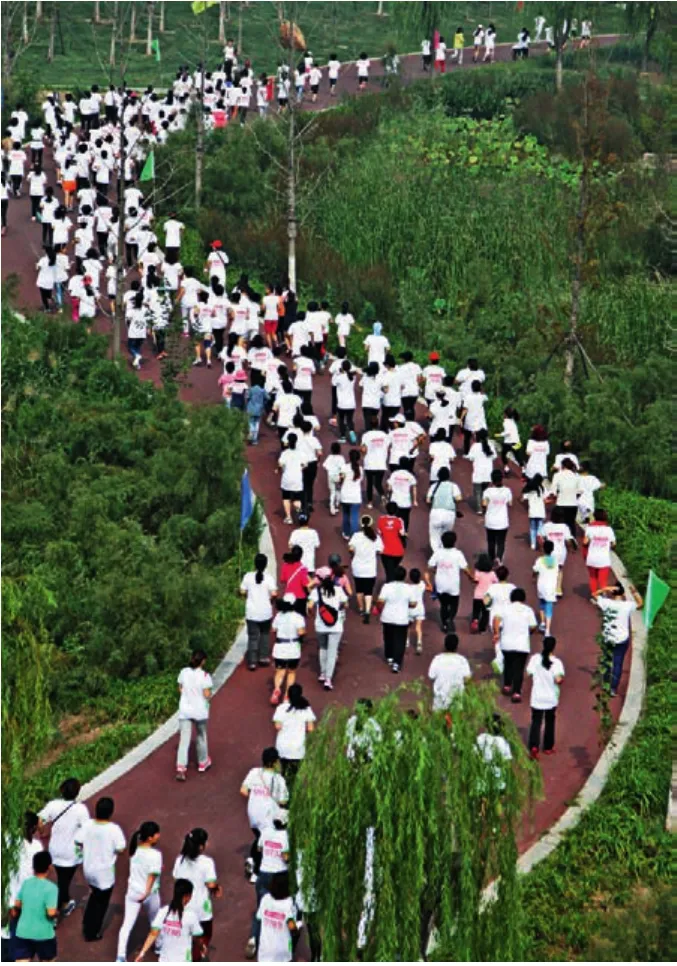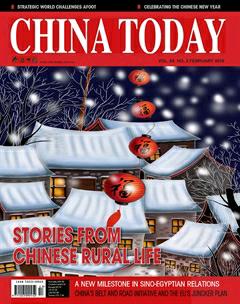Let’s run Together
By staff reporter JIAO FENG
Let’s run Together
By staff reporter JIAO FENG

Locals in Binzhou of Shandong Province participate in a mini-marathon on September 19, 2015.
M ORE than 1,000 runners completed the 21-km Beijing Mountain Half Marathon course on November 22, 2015, despite windy, snowy weather.
In recent years running has become a popular pursuit in major Chinese cities. More than two million residents of Beijing, for example, are regular long distance runners, according to incomplete statistics. There are no fewer than 80 specialized running mobile phone apps. There have been more than 25 million downloads of Codoon, China’s earliest social networking exercise app, and its users now exceed 30 million.
More Than Just Exercise
On the day of the Mountain Half Marathon, Wu Zili traveled all the way from Yansha Bridge to the Olympic Forest Park, despite blizzards, to start her weekend with her usual 8:30 jog. Although fewer people were in the park than in good weather, joggers were nonetheless well represented that day.
Wu Zili, 46, told the reporter that she started jogging just six months ago. At that time she weighed 93 kg, and had high blood sugar and blood lipids. This excess weight also caused her pain in the knees and ankles. Wu’s physician told her that she was in poor condition and needed to lose weight. That was when the jogging started. “At first, it was hard. Even half an hour on the treadmill was an arduous struggle. But now two hours seems relatively easy. I think jogging could become an addiction, because running 10 km each day has become an indispensable part of my everyday life,”Wu said.
Wu has since reduced her weight to 70 kg. In her view, “Jogging can make you healthier, but there are four other benefits it has to offer.” Working in a state-owned enterprise, she earns a relatively good salary, but is also subject to huge pressure. She often has to work overtime, and is sometimes unable to fall asleep until the small hours. “I used to suffer from mild insomnia, headaches, tiredness, and felt generally listless. Things are much better since I began jogging. I’ve become more energetic, and the exercise both cheers and relaxes me.” More importantly, her world outlook has undergone a transformation. “I jog for jogging’s sake rather than for specific results. Life could be so much simpler without superfluous worldly possessions, and a simple life calms and relaxes you,” Wu said.
Yang Xinxin, 39, majored in science and engineering and works as senior engineer at a multi-national corporation. He has been running for two years. An introvert with a relatively specialized job, Yang’s social life outside of work was low-key and limited. But everything changed after he joined the “Running Beijing” interest group. They meet every Thursday evening and run through Beijing’s streets, lanes and hutong. Their numbers include specialized team members who tell them the background and stories about the places they pass by.“This gives me a better understanding of the city’s history and culture,” Yang Xinxin said. Each time he tweeted the stories he’d heard and the feelings they evoked, Yang would receive a surge of feedback. “I began to chat about sports and culture with people I hadn’t previously interacted with, and so become more closely acquainted.”
Sin ce We Ch at in t r od u ced t h e “WeChat Sports” public account, many office workers have begun running or walking, and to compete with friends for positions on the billboard. Wu, who until recently was never a sports fan, now often takes the lead among her friends. Some even challenge her to competitions. “We encourage and supervise each other. This has made sports more interesting and also motivated us,” Wu said.
Nationw ide Marathon Mania
Cui Shaoping from Shenzhen tweeted on December 9 that he had signed for the 2015 Futian Green Trail Marathon. Owing to the huge number of applicants, however, organizers had to choose participants through a lottery, and Cui lost out. This left him crestfallen and disgruntled.
Since middle school, Cui has been keen on running and playing football. His marathon debut was in 2009 in Shenzhen, at the SEZ’s maiden race. “I remember clearly that only 831 participants took part in the 2009 marathon. But this number grew to 10,000 in 2014, and increased again in 2015,” Cui said.
In 1981, only 86 people ran the Beijing International Marathon, but 21,163 competitors signed up for the Beijing International Race in 2014. The year 2015 saw a new record of 63,118 runners, far exceeding the 30,000 limit. Consequently only half of applicants were able to take part in the event.
There are 53 marathon races registered with the Chinese Athletics Association, but the real number is much higher. In 2015 about 120 marathons were held, according to unofficial statistics, 44 of which took place in November and December alone. The Chinese Athletics Association has discontinued the examinations and approval procedure for marathon races, a move that has created their easier access and wider participation.
Cui loves running marathons. Apart from in his native Shenzhen, he competes in such events throughout the country when time permits. He takes with him his 15-year-old son, Cui Qiaoyi, who has been running marathons for two years.
Running is truly an all encompassing pursuit, because in addition to stimulating game operations and sales of sports products, it also promotes other industries like sports coaching, healthcare, and tourism.

An international marathon kicks off in Lianyungang, eastern China, on October 25, 2015.
Cui said, “In a marathon, you translate the difficulties of running into specific numbers. A 42 km course is a huge challenge. But overcoming your limitations and completing the distance makes you realize that you have far greater potential than you ever imagined. This, in a nutshell, is the main benefit and source of fun of marathons for me. And I feel uplifted after each race. In 2016, I plan to run marathons overseas. Taking annual leave in another country and running a marathon there should be no problem!”
Running Boosts Industrial Chain
As the number of runners increases, so too does their demand for equipment. Running has thus created a complete industrial chain.
Yang Xinxin has three pairs of running shoes for different seasons. When he started running two years ago, his kit comprised standard T-shirts and sweat pants. But since joining the group, this fundamental wear no longer fits the bill. His current kit includes: wash and wear shirts, long spandex hose, sports shorts, a fleece sweater, thermos flask, an MP3 with mega storage, a waist bag, and a wrist band. Including his shoes, it cost him about RMB 3,000. “That’s just medium expenditure. More advanced kits cost about RMB 5,000,” Yang said.
It’s plain to see that all major sports brands promote running products. Statistics show that running shoes now account for 30 percent of the sports shoe market, a first ranking among all sports equipment.
“Runners are now avid consumers of equipment, which implies a new level of sports consumption. In the past, people wore standard gym shoes, but now prefer professional sports footwear. This change is fueled by both higher living standards and a changed consumption mentality. Sports shoes that reduce shock, improve ventilation, and absorb sweat are bound to make running more comfortable and enjoyable,” Cui said.
The year 2015 saw Shenyang’s first marathon race. According to the official site, among the 15,000 people who signed up, about one third were not locals. There were also scores of runners from other countries, including Russia, South Korea, Kenya, and Ethiopia. The event undoubtedly boosted the city’s catering, accommodation and transportation industries.
Running is truly an all-encompassing pursuit, because in addition to stimulating game operations and sales of sports products, it also promotes other industries like sports coaching, healthcare, and tourism. A complete industrial chain has thus been established, and a grand economic bonanza is on the horizon.

